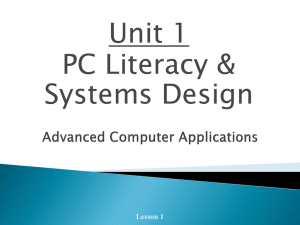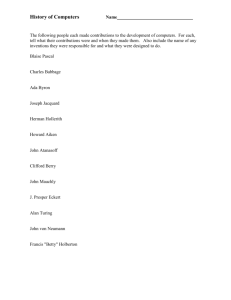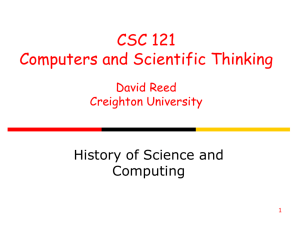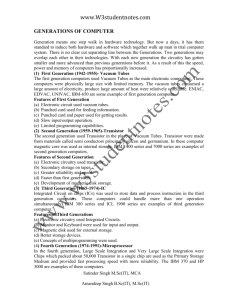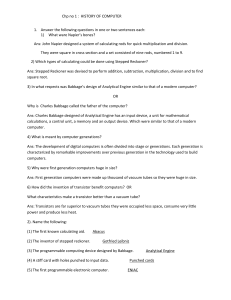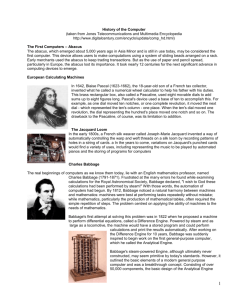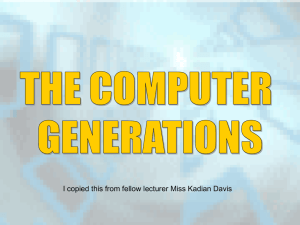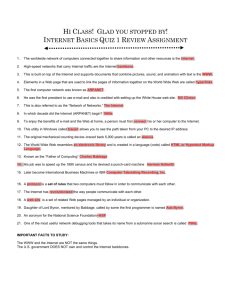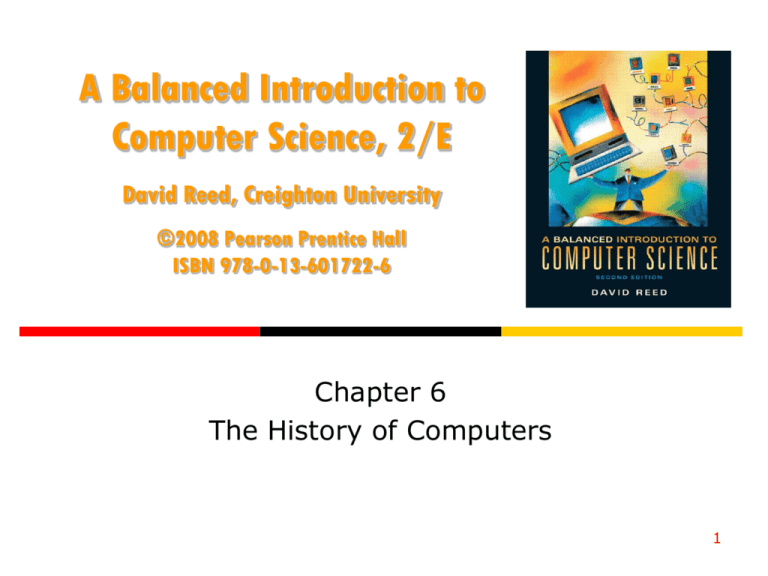
A Balanced Introduction to
Computer Science, 2/E
David Reed, Creighton University
©2008 Pearson Prentice Hall
ISBN 978-0-13-601722-6
Chapter 6
The History of Computers
1
2
History of computing
calculating devices have been around for millennia (e.g., abacus ~3,000 B.C.)
modern "computing technology" traces its roots to the 16-17th centuries
as part of the "Scientific Revolution", people like Kepler, Galileo, and Newton
viewed the natural world as mechanistic and understandable
this led to technological advances & innovation
from simple mechanical calculating devices to powerful modern computers,
computing technology has evolved through technological breakthroughs
3
Generation 0: Mechanical Computers
1642 – Pascal built a mechanical calculating machine
used mechanical gears, a hand-crank, dials and knobs
other similar machines followed
1805 – the first programmable device was Jacquard's loom
the loom wove tapestries with elaborate, programmable patterns
a pattern was represented by metal punch-cards, fed into the loom
using the loom, it became possible to mass-produce tapestries,
and even reprogram it to produce different patterns simply by
changing the cards
mid 1800's – Babbage designed his "analytical engine"
its design expanded upon mechanical calculators, but was programmable via
punch-cards (similar to Jacquard's loom)
Babbage's vision described the general layout of modern computers
he never completed a functional machine – his design was beyond the
technology of the day
4
Generation 0 (cont.)
1890 – Hollerith invented tabulating machine
designed for tabulating 1890 U.S. Census data
similar to Jacquard's loom and Babbage's analytical
engine, it stored data on punch-cards, and could sort
and tabulate using electrical pins
using Hollerith's machine, census data was tabulated in
6 weeks (vs. 7 years for the 1880 census)
Hollerith's company would become IBM
1930's – several engineers independently built
"computers" using electromagnetic relays
an electromagnetic relay is physical switch, which can
be opened/closed via electrical current
Zuse (Nazi Germany) – his machines were destroyed
in WWII
Atanasoff (Iowa State) – built a partially-working
machine with his grad student
Stibitz (Bell Labs) – built the MARK I computer that
followed the designs of Babbage
limited capabilities by modern standards: could store only
72 numbers, required 1/10 sec to add, 6 sec to multiply
still, 100 times faster than previous technology
5
Generation 1: Vacuum Tubes
mid 1940's – vacuum tubes replaced relays
a vacuum tube is a light bulb containing a
partial vacuum to speed electron flow
vacuum tubes could control the flow of
electricity faster than relays since they had no
moving parts
invented by Lee de Forest in 1906
1940's – hybrid computers using vacuum tubes
and relays were built
COLOSSUS (1943)
first "electronic computer", built by the British
govt. (based on designs by Alan Turing)
used to decode Nazi communications during
the war
the computer was top-secret, so did not
influence other researchers
ENIAC (1946)
first publicly-acknowledged "electronic
computer", built by Eckert & Mauchly (UPenn)
contained 18,000 vacuum tubes and 1,500
relays
weighed 30 tons, consumed 140 kwatts
6
Generation 1 (cont.)
COLOSSUS and ENIAC were not general purpose computers
could enter input using dials & knobs, paper tape
but to perform a different computation, needed to reconfigure
von Neumann popularized the idea of a "stored program" computer
Memory stores both data and programs
Central Processing Unit (CPU) executes by loading program instructions from
memory and executing them in sequence
Input/Output devices allow for interaction with the user
virtually all modern machines follow this
von Neumann Architecture
(note: same basic design as Babbage)
programming was still difficult and tedious
each machine had its own machine language, 0's & 1's corresponding to the
settings of physical components
in 1950's, assembly languages replaced 0's & 1's with mnemonic names
e.g., ADD instead of 00101110
7
Generation 2: Transistors
mid 1950's – transistors began to replace tubes
a transistor is a piece of silicon whose conductivity
can be turned on and off using an electric current
they performed the same switching function of
vacuum tubes, but were smaller, faster, more reliable,
and cheaper to mass produce
invented by Bardeen, Brattain, & Shockley in 1948
(earning them the 1956 Nobel Prize in physics)
some historians claim the transistor was the most
important invention of the 20th century
computers became commercial as cost dropped
high-level languages were designed to make programming more natural
FORTRAN (1957, Backus at IBM)
LISP (1959, McCarthy at MIT)
BASIC (1959, Kemeny at Dartmouth)
COBOL (1960, Murray-Hopper at DOD)
the computer industry grew as businesses could afford to
buy and use computers
Eckert-Mauchly (1951), DEC (1957)
IBM became market force in 1960's
8
Generation 3: Integrated Circuits
mid 1960's - integrated circuits (IC) were produced
Noyce and Kilby independently developed techniques
for packaging transistors and circuitry on a silicon chip
(Kilby won the 2000 Nobel Prize in physics)
this advance was made possible by miniaturization &
improved manufacturing
allowed for mass-producing useful circuitry
1971 – Intel marketed the first microprocessor, the 4004,
a chip with all the circuitry for a calculator
1960's saw the rise of Operating Systems
recall: an operating system is a collection of programs that manage peripheral
devices and other resources
in the 60's, operating systems enabled time-sharing, where users share a
computer by swapping jobs in and out
as computers became affordable to small businesses, specialized programming
languages were developed
Pascal (1971, Wirth), C (1972, Ritche)
9
Generation 4: VLSI
late 1970's - Very Large Scale Integration (VLSI)
by the late 1970's, manufacturing advances allowed placing hundreds of
thousands of transistors w/ circuitry on a chip
this "very large scale integration" resulted in mass-produced microprocessors and
other useful IC's
since computers could be constructed by simply connecting powerful IC's and
peripheral devices, they were easier to make and more affordable
(Intel Research. “Silicon—Moore’s Law.” October 2006.)
10
Generation 4: VLSI (cont.)
with VLSI came the rise of personal computing
1975 - Bill Gates & Paul Allen founded Microsoft
Gates wrote a BASIC interpreter for the first PC (Altair)
1977 - Steve Wozniak & Steve Jobs founded Apple
went from Jobs' garage to $120 million in sales by 1980
1980 - IBM introduced PC
Microsoft licensed the DOS operating system to IBM
1984 - Apple countered with Macintosh
introduced the modern GUI-based OS (which was mostly
developed at Xerox)
Richest People in the World
(Forbes.com, 3/8/07)
1. Bill Gates
$56 billion
2. Warren Buffet
$52 billion
3. Carlos Slim Helu
$49 billion
4. Ingvar Kamprad
$33 billion
5. Lakshmi Mittal
$32 billion
.
.
.
19. Paul Allen
$18 billion
1985 - Microsoft countered with Windows
1980's - object-oriented programming began
represented a new approach to program design which views a program as a
collection of interacting software objects that model real-world entities
Smalltalk (Kay, 1980), C++ (Stroustrup, 1985), Java (Sun, 1995)
11
Generation 5: Parallelism/Networks
the latest generation of computers is still hotly debated
no new switching technologies, but changes in usage have occurred
high-end machines (e.g. Web servers) can have multiple CPU's
in 1997, highly parallel Deep Blue beat Kasparov in a chess match
in 2003, successor Deep Junior played Kasparov to a draw
most computers today are networked
the Internet traces its roots to the 1969 ARPANet
mainly used by government & universities until the
late 80s/early 90s
(“Internet Domain Survey.” Internet Software Consortium,
July 2006.
the Web was invented by Tim Berners-Lee in
1989
designed to allow physics researchers to share data and
documents
not popular until 1993 when Marc Andreessen
developed a graphical browser (Mosaic)
Andreessen would go on to found Netscape, and
Internet Explorer soon followed
“Netcraft Web Server Survey.” Netcraft, July 2006.)
12

